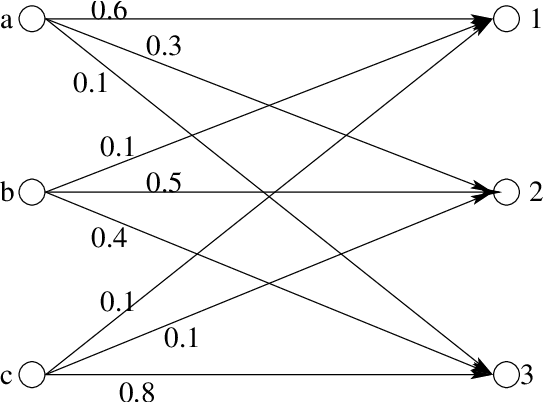Note: the material in sections A.1 and A.2 has been covered in ECE 528 and you are expected to be familiar and comfortable with that material.
- A noisy discrete communication channel is available. Once each second
one letter from the three-letter alphabet {a,b,c} can be transmitted
and one letter from the three-letter alphabet {1, 2, 3} is received. The
conditional probabilities of the various received letters, given the
various transmitted letters are specified by the diagram in the
accompanying diagram.

The source sends a, b, and c with the following probabilities:
![P [a] = 0.3
P[b] = 0.5
P[c] = 0.2](hw_6301x.png)
- Compute all (nine) conditional probabilities of the form P(X|Y ) for X ∈{a,b,c} and Y ∈{1, 2, 3}.
- Compute all (nine) joint probabilities of the form P(X,Y ) for X ∈{a,b,c} and Y ∈{1, 2, 3}.
- A receiver makes decisions as follows:
- If 1 is received, decide a was sent.
- If 2 is received, decide b was sent.
- If 3 is received, decide c was sent.
What is the probability that this receiver makes a wrong decision? (I.e.., its decision is different from what was actually sent.)
- What is the best receiver decision rule (assignment from 1, 2, 3 to a, b, c)?
- What is the resulting probability of error?
- Consider a random variable X having a double-exponential (Laplacian)
density,

where a and b are positive constants.
- Determine the relationship between a and b such that pX(x) is a valid density function.
- Determine the corresponding probability distribution function PX(x).
- Find the probability that the random variable lies between 2 and 3.
- What is the probability that X lies between 2 and 3 given that the magnitude of X is less than 3.
- Let x1, x2, …, xN be a set of N identically distributed statistically
independent random variables, each with density function px
and distribution function Fx. These variables are applied to a
system that selects as its output, yN, the largest of the {xi}, i.e.,
yN = max{x1,x2,…,xN}. Clearly, yN is a random variable.
- Express pyN in terms of N, px, and Fx.
- Assume now that the xi are exponentially distributed random
variables:

Calculate the expectation E[yN] for N = 1, 2.
- Path Loss and SNR Friis transmission equation

describes the path loss Lp under line-of-sight propagation conditions as a signal travels from transmitter to receiver.
- Convert the path loss expression above to a logarithmic scale (i.e., to dB) by taking 10 log 10(⋅) of both sides of the relationship.
- The transmitter of a communication system sends signals with the
following parameters:
- transmit power Pt = 10dBm
- bandwidth W = 10MHz
- carrier frequency fc = 1GHz
Compute the received power Pr, as a function of the distance d between transmitter and receiver. Express Pr in dBm, i.e., compute 10 log 10(
 ).
).
- The communication system is impaired by thermal noise and is
designed so that a signal-to-noise ratio
 of at least 10 dB is
required for successful operation. What is the maximum distance d
for which the system will work?
of at least 10 dB is
required for successful operation. What is the maximum distance d
for which the system will work?